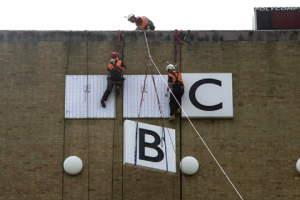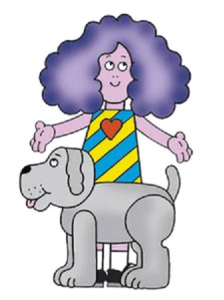Ugly East Tower is designer’s muse
From “Ariel”
(Click on the picture below to see a larger or clearer version of this picture:
Click the “X” button (top right) to close the newly opened picture.)

Many regard it as an ugly Sixties tower block, but one former BBC designer has taken East Tower as an artistic muse.
Hilary Hayton has created day and night screen prints to celebrate the former home of BBC children’s programmes at Television Centre.
‘I wanted to portray the energy once generated by this building,’ she tells Ariel. ‘It was such an exciting place to work in the Sixties and Seventies. TVC was bursting with creativity and opportunity; there were so many highlights.’
It was where Hayton established a department of 16 artists and photographers dedicated to the images used on children’s programmes.
Hilary Hayton designed titles for the likes of “Play School” – they were the first transmission on BBC Two – “Jackanory” and “Play Away”. She also created 1970s cult children’s cartoon “Crystal Tipps and Alistair” – dialogue-free stories about a bushy-haired girl and her pet dog.
(Click on the picture below to see a larger or clearer version of this picture:
Click the “X” button (top right) to close the newly opened picture.)
She left the BBC after 16 years in 1977 to start her own animation studio, creating, producing and directing a number of programmes, until computer animation took a grip of the industry. ‘I gave my film equipment to Chelsea College of Art and returned to my original roots in art – painting and screen printing,’ she says.
The latter involves creating a negative or black image for each colour on the print, developing that image onto a silk screen, printing and then registering each colour separately on archival paper.
For those of a nostalgic bent, Hayton’s limited edition Television Centre screen prints are a chance to remember the building as it was. The children’s department moved to Salford in 2011 and the TVC site is being redeveloped by its new owners.
The much-maligned East Tower, meanwhile, is being razed to the ground before it is reborn as an elegant residential block.
Geoff Hawkes
You may have heard DG Tony Hall talking to Martha Kearney on “The World At One” about the proposal for the BBC to start making programmes for its rivals, now that the rivals are to be allowed to compete for a much bigger share of the cake than the 25% agreed under Maggie Thatcher. Like me, you may have then thought:
“Good idea, and what you need is a big round, beautifully designed iconic building with purpose built studios complete with fully equipped workshops, trained staff, storage, servicing and dining facilities, audience reception areas, multi storey car park for the staff and two tube stations just across the road.”
The only snag is, where on earth could there possible be such a dream place – and even if there was, surely no-one in their right mind would ever consider parting with it…
(Click on the picture below to see a larger or clearer version of this picture:
Click the “X” button (top right) to close the newly opened picture.)

Pat Heigham
Re-arrange the following words to make sense:
bolted
door
horse
stable
Well, it makes a change from ITV companies making programmes for the BBC (Granada did plenty). But there’s always Salford….
Ian Dow
Before BBC OBs were sold we had been doing that for some time including the Grand Prix for ITV, Chris Evans’ Friday night show for Channel 4 from Riverside Studios, and a live weekly “spy chase” show for Channel 4 with OBs from across the UK and the linking studio with audience built in the OB Garage in Kendal Avenue.
Nothing new!
John Howell
Thames Television made a “This is Your Life” in TC1 with BBC staff!
(It was Rolf Harris; clearly the book was incomplete).
Ian Hillson
The Times put a different spin on it all: “Doctor Who” may be outsourced in BBC ‘revolution’
“… The BBC will outsource the making of hundreds of millions of pounds’ worth of TV programmes to commercial producers to save money.
The corporation’s in-house production department, which makes shows such as “Doctor Who”, “Top Gear” and “Strictly Come Dancing”, will no longer be protected by quotas and will have to compete with commercial rivals for commissions, it is understood.
In return, the BBC wants its production department to be free to make shows directly for other broadcasters, particularly in America, in order to generate new revenues and secure the BBC’s international position.
The “competition revolution” will be announced by Lord Hall of Birkenhead, the BBC’s director-general, at a media conference in London . It is the latest move in Lord Hall’s attempt to reform the BBC.
Lord Hall will firmly reject calls by independent TV companies for the corporation to privatise all of its production, arguing that the BBC would squander generations of programme making expertise and lucrative intellectual property rights if it does not make some of its own shows.
However, it will scrap the current quota system under which at least 50 per cent of BBC programmes are made internally, 25 per cent are made by independent producers and the remainder is open to both.
Many in the broadcasting industry argue that the quota system is inefficient and that commercial producers could make much of the BBC’s output at lower cost.
Some of the corporation’s most popular programmes are already made by the private sector: “Sherlock” is produced by Hartswood Films; “Question Time” is made by Mentorn Media.
The broadcaster has to find £100 million from existing budgets to fund Lord Hall’s plans and faces further cuts when the BBC comes to renegotiate its royal charter with politicians in 2016…”
One step closer to becoming a publishing company – like Channel 4.
Mike Jordan
I wonder what will happen in future for shows like “Children In Need”.
Obviously Salford/Glasgow etc are not suitable for this kind of show having either no studios or none with correct size/facilities.
I can’t believe TC1 will be able to be used with anything like an “event” outside when it is surrounded by upmarket flats.
I guess they only got away with the BH bit as hardly any people live that close by.
So it is probably back to a Dance Studio in Elstree again …
Ian Dow
Pacific Quay Studio A in Glasgow is HD and has done some of the peak Saturday evening entertainments, and at 7825 sq ft is between the size of TC1 and TC3, so could probably do CIN at a push. There is a another smaller studio, just a bit bigger than TC2, as a Green Room, and quite a lot of space in the building.
“Showlight 2009” was mounted in Studio A at Pacific Quay, and we also cleared out the scenery store and had quite a large exhibition in there with 350 delegates.




